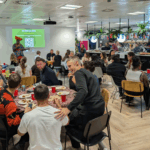Against Homophobia, Transphobia and Biphobia.
Article written by Marc Lesner, Partner at Investigo US.
The day is now celebrated in more than 130 countries, including 37 where same sex acts are illegal.
Our roundtable discussions provide a safe environment for In Group people to talk frankly about their experiences and help to increase each other’s understanding of the most sensitive issues affecting the workplace. Marc Lesner, who heads up the Pride subcommittee of our DEI committee, led a roundtable discussion on the International Day Against Homophobia, Transphobia, and Biphobia.
Founded in 2004, this global annual landmark aims to draw the attention of decision-makers, policymakers, the media, and the general public to the challenges still faced by people with diverse sexual orientations, gender identities or expressions, and sex characteristics. The specific date of May 17th was chosen to commemorate the World Health Organisation’s decision to declassify homosexuality as a mental disorder in 1990 – a date that’s more recent than many of us might have expected.
The roundtable gave our panel the chance to highlight some of their own personal experiences of homophobia, biphobia, and transphobia and share their advice on how we can all be more supportive of people from these communities.
Early homophobia – how first experiences set the tone
Marc’s first experience of homophobia was at school: “The word ‘gay’ being used in the context of, ‘that’s so gay.’ For that term to be used to denote something that’s bad or stupid probably impacted me subconsciously.
You’d never want something that’s such a big part of your life, something that’s so inherent to who you are, to be viewed negatively.”
Though this usage of the word has diminished over time, individuals do still subconsciously use it in this context – not necessarily with any malice, but as a result of growing up hearing it used in a negative way. “I think I’m now at a stage where I would call somebody out on that explicitly, explain why it shouldn’t be said, and how it would make somebody feel,” said Marc.
That’s why thinking about the language we use is so important. “If you were to turn around and ask if they’ve got a problem with gay people, they’d probably say no,” said Terry Dawson, a vocal ally for our Pride subcommittee. “But they’re almost not linking that insult to someone’s sexuality. It’s a throwaway comment, but throwaway comments can be really harmful. It shows people need to educate themselves about the potential impact of that kind of language.”
Out of earshot – but not out of mind
These kinds of comments are no more acceptable – and no less damaging – when made in a closed group. They only serve to breed, embed, and normalise ongoing incorrect behaviour, which can also slip out in a public forum and offend somebody. By actively being an ally and creating a ripple effect on those around us – including having the courage to call out this kind of language – we can have a significant impact on the quality of someone’s life.
Why allies are so important
We can’t underestimate the importance of allies, especially from outside the LGBTQ+ community, who are willing to learn about the challenges faced by underrepresented groups and make sure they have a voice. “It seemed like a good opportunity to make a difference,” said Terry, explaining his desire to get involved. “If I can educate others on what I’ve learned and be a good ally, if not necessarily an expert, then all the better.”
Education’s crucial in increasing our understanding, whether it’s reading a book, watching a film, supporting LGBTQ+ charities, or getting involved in campaigning. Asking questions is also a big part of that education. “Don’t be afraid to be inquisitive,” said Terry. “If you’ve got a genuine question, and you don’t want to offend somebody, it’s better to ask in the right way than to never learn or understand. We all need to make sure that we’re sensitive to other people’s feelings.”
While we often talk about gender and racial diversity on boards, we don’t talk much about LGBTQ+ representation. Only 26 of the 5,670 Fortune 500 board positions are held by LGBTQ+ individuals, which amounts to 0.4%.
Educating from an early stage
While our awareness of these subconscious verbal transgressions will often increase as we mature, it’s important that we pass on our lessons to young people. If you’re a parent, having a conversation with your child about treating everyone fairly and taking a stand for their LGBTQ+ friends is invaluable.
“Growing up, I would probably have talked about not being racist, but I don’t think my parents ever said, ‘make sure you treat gay or trans people fairly.’ Just having that conversation with your child can hopefully have a knock-on effect throughout society,” said Marc. Again, this is where allies, particularly from outside the community, can have such a huge impact. “It immediately makes me feel more supported that there are allies out there that really want to make a difference,” he added.
Why is it important that we recognise these days?
The rights of the LGBTQ+ community have evolved so much in recent years, most notably with the legalisation of same-sex marriage. While we should recognise that we’ve come a long way, there continues to be widespread homophobia, biphobia, and transphobia, even in westernised countries which are more advanced in their thinking.
Days like this highlight the experiences of people in this community and remind us that there’s still a lot of work to do.
Changing this will require not only a seismic cultural shift but a shift in the mindsets of these individuals – some of whom may feel reluctant to aim for these roles because of the discrimination they faced growing up. Organisations need to make a conscious effort to be as inclusive as possible across all types of diversity, making a systemic change to foster a real sense of inclusivity amongst their workforces.
Changing people to suit the world around them – or changing the world so everyone’s welcome?
“We’ve certainly made a lot of strides in the past 10 years, but it’s still somewhat of a jagged line, and we still have a long way to go,” said one attendee, who described the challenges he experienced as a gay person growing up in a very religious household. “Before I came out, it was thrown around pretty often how people like me were going to hell. My parents put me in conversion therapy when I was in my early teens.”
Up until 2020, when it was banned in the US state of Utah, where this particular attendee grew up, conversion therapy – carried out by licenced therapists and aiming to change a person’s sexual orientation or gender expression – had been a common practice. It was also linked to higher rates of suicide, homelessness, and drug use among minors. While conversion therapy is now banned in the UK for gay people, it still exists for trans people, and the legislative battle will need to continue.
“When I officially came out at the age of 18,” he continued, “I became a stranger for my family and was even homeless for a time. So it definitely had numerous effects on my confidence and self-value for a long time.” His experience really shows why these days of recognition and reflection are so important. From a visibility perspective, the more people see something that they’re not familiar with, the less abstract it becomes.
This is where queer representation in the media really has an impact. The increase in the number of LGBTQ+ characters in films and TV series, for example, is helping to increase visibility and, therefore, acceptance from outside the community.
The trans vacuum
In 2021, there were 375 trans murders, the highest figure in history.
While gay representation is increasing, the same cannot be said of the trans community, which is still often marginalised. There’s very little trans representation in the media beyond drag shows, which can fuel misconceptions. “For people that tend to be more on the fringes even within the queer community, such as trans people, I think there needs to be a lot of focus on making sure those people have more visibility and feel included as well,” said Anna Koutelas from our New York office.
Our panel shared their experiences of working with trans colleagues at various stages of their transition. Those who have witnessed an entire transition over a period of years – the operations, hormonal changes, injections, and medication, not to mention the minor cosmetic alterations to clothing and hair – have really gained an understanding of the physical, mental, and emotional turmoil involved.
You don’t go through a process like that on a whim. You don’t go through a process like that unless you’re absolutely sure you’re not living the life you’re supposed to be living.
Why difficult conversation can make lives easier
Allyship not only provides crucial support for people undergoing such a change but also increases our understanding. We’re often understandably reluctant to ask questions about an incredibly sensitive issue because we’re scared of causing offence. But asking questions will help us grow our knowledge and show a trans person that they’re not facing this challenge alone. “It really opened up my eyes and told me not to be afraid to ask questions,” said one attendee. They described how a former colleague of theirs had been desperate to talk about their transition from female to male and also wanted to become more accustomed to interacting with the males in the office.
The process of transition presents a whole set of challenges that many of us could never even comprehend. That’s why we should actively offer our support and allyship and why organisations should amend their internal policies to cater for trans employees. People’s common mistake is avoiding the issue.
Don’t be afraid to approach someone and have an honest chat. By taking the easy way out and avoiding an issue that makes us uncomfortable, we risk alienating trans people even further.
They might really appreciate having a sounding board – especially a new acquaintance – when many of the existing people in their life still see them as the old person. If they don’t want to talk about it, then providing you approach them with courtesy and sensitivity, that’s not a problem.
Bisexual stigmas
The danger of grouping very different people together into a single community is that we lose sight of their individual challenges. There’s a perception that bisexual people are chameleons of sorts, able to fit into whichever community they want. However, this often isn’t the case. Anna shared some of the stigmas of bisexuality she’s experienced, both within heterosexual and homosexual communities.
“Some of the heterosexual people I’ve met have equated bisexuality with promiscuity,” she said. “People can assume that because you can be attracted to both men and women, that you are attracted to both men and women at the same time, all the time.” This attitude can cause bisexual people not to openly identify as bisexual in public. “I don’t want the reaction that comes with telling people that I’m bi. People can assume that you want to engage with both them and their partner. But bisexual people can be just as monogamous as straight people.”
Perhaps more surprising is the stigma that bisexual people receive within the queer community. “I always assumed that if you were under the queer umbrella, there would be a sense of camaraderie and overall acceptance,” said Anna. “That it’s kind of one big happy family. But oftentimes, this isn’t the case. In the lesbian community, in particular, it can be a huge red flag if you’re bisexual. Some people can think that if you identify as bisexual, you’re just a straight girl who’s experimenting and going through a phase.”
It can feel hard for bisexual women to fit into a safe space where men are intentionally boxed out. That’s why it helps if people within these safe spaces remain open to different forms of female queerness beyond the strict label of lesbian. “The nuances, the funny and fuzzy lines, and the grey areas within our sexuality shouldn’t be reason to exclude people or box them out. People should be celebrated for being uniquely themselves, whatever that may look like, and whatever trajectory they’re on in their dating life.”
Perceptions, personality and the problems with presentation
There are also stigmas with sexual presentation in the lesbian community. Within different queer communities in different parts of the world, Anna’s experienced very different perceptions of how a lesbian should look and behave. In some countries, she’s experienced the idea of a “cookie cutter lesbian,” whereby a person is expected to dress and look stereotypically lesbian, which is seen as more traditionally masculine. This can make it very difficult for a person to immerse themselves in a queer community and find the fellowship they need.
“One of the many things that I just love about New York is that I haven’t had this expectation to look a certain way as a queer woman. You can be a lipstick lesbian; you can be a ChapStick lesbian; you can be a butch lesbian; you can be anything in between. There seems to be a lot more openness to the way you physically present yourself and your sexuality. Humans are dynamic; we all have our own individual paths and sexualities, some definitely more complex than others. Rather than boxing someone out or making them not feel welcome in a space for their sexuality, I really feel that our individuality and our sexuality should be nothing but embraced, supported and celebrated.”
Perhaps the spirit of the discussion was captured most succinctly by one comment from the floor: “I would have really liked if someone had said, ‘You’re welcome in this space, just as you are, and you don’t have to change anything about yourself to fit into this space as a queer person.” Maybe that’s a lesson we can all learn not just when actively being allies but in our interactions with everyone we meet.
The lessons
Same sex acts remain illegal in 70 countries.
Thanks to our wonderful panel, who were prepared to put themselves on the line to discuss an extremely complex, and sometimes very personal topic, we picked up some simple lessons that can make a big difference to people’s lives every day:
- Be careful of the words you use and be conscious of the impact they can have on others.
- If something doesn’t sit well, call it out.
- Allyship is really important. You don’t have to be an expert – just be open, understanding, and willing to listen.
- Don’t be afraid to ask questions – this will help you support someone who really needs it, increase your understanding, and make you more comfortable with a sensitive issue.
- As an organisation, foster a sense of inclusivity, so everyone knows they have a chance to progress.
It’s by opening ourselves up and having, at times, uncomfortable conversations that we can educate both ourselves and others, allowing us to create better experiences for people who are underrepresented or going through difficulty. To discuss any of the points raised in our roundtable or for advice on how to foster an inclusive workplace, contact our DEI committee. They’d love to help.
Share this:




